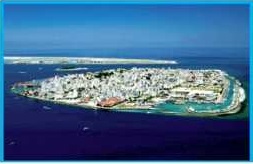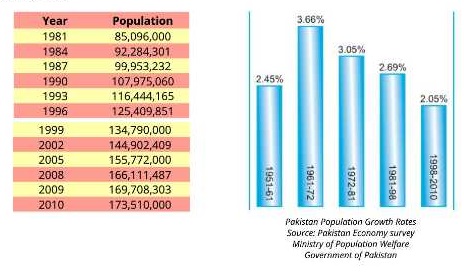Q.9 Explain Ecosystem Balance and Human Impact.
Answer:
(a) Interaction among organisms
The interactions among organisms and between organisms and their abiotic components of their environment produce steady and balanced ecosystem.
(b) Biogeochemical cycles
Biogeochemical cycles also maintain the balance in ecosystems by recycling natural resources, so that they do not deplete.
(c) Disturbance of the balance in ecosystem
Humans try to modify environment (e.g. cutting of trees) to fulfill their needs. This has upset the delicate balance in ecosystems and nature as well. Some of the human impacts on the balance of ecosystems and nature are described as follows;
1. Global Warming
(a) Process of temperature increase
The addition of greenhouse gases (e.g. carbon dioxide, methane, ozone) in atmosphere increases the temperature of the earth. These gases in the lowest part of Earth’s atmosphere do not allow solar radiations to reflect back into space. As a result, heat remains within the Earth’s atmosphere and increases its temperature. This is called global warming.
(b) Effect of global warming
Due to global warming, polar ice-caps and glaciers are melting faster than the time taken for new ice layers to form. Sea water is also expanding causes sea level to rise. Due to melting glaciers, rivers overflow and cause floods.
(c) Threat to the Maldives’ Survival
Scientists fear that the sea level is rising up to 0.9 cm a year. Rise in sea level has worst effects on coastal countries. Most of the islands of the Maldives are less than 1 metre above sea level. It is estimated that within 100 years, the Maldives might become uninhabitable and the citizens would be forced to evacuate.

(d) Green House Effect
It refers to the phenomenon in which certain gases (Carbon dioxide, methane, nitrous oxide) called greenhouse gases trap heat in the atmosphere. These gases act like the glass in a green house, which does not allow the inner heat to escape. When sunlight reaches the surface of the earth, much of its energy is transformed into heat energy. The earth surface reflects this heat energy towards space as infrared radiation. The greenhouse gases trap these and send it back to earth which increases temperature.
2. Acid rains
Certain chemicals such as oxides of sulphur and nitrogen when react with water vapours in the presence of sunlight to form sulphuric acid and nitric acid. These acids remain as vapours at high temperatures. As temperature falls, the acids begin to condense into liquid form and mix with rain or snow. On the way down to the earth, this makes rain acidic with pH range of 3-6. Effects of acid rains
1) Lowering in pH
Acid rain destroys the necessary nutrients present in the water of rivers and lakes etc. It also lowers the pH of water. Most of the aquatic animals cannot survive at this pH.
2) Damages to Plants
Acid rain washes nutrients out of soil, damages the bark and leaves of trees and harms root hairs. Leaf pigments (chlorophyll) are also destroyed.
3) Corrosion on Metallic surfaces
Metallic surfaces exposed to acid rain are easily corroded. Fabrics, paper and leather products also lose their material strength.
4) Weakening on Building Material
Building materials such as limestone, marble, dolomite, mortar and slate are weakened with acid rains because of formation of soluble compounds. The building of famous Taj Mahal has been corroded at many places, due to acid rains.

3. Deforestation
Definition
Deforestation means clearing of forests by natural causes or humans.
Causes of deforestation
• Large areas of forests have been cleaned for agriculture, factories, roads, rail tracks and
mining.
• Humans cut trees for getting wood (lumber), which is then used for making structures and for
heat production.
• Human preys upon forest animals, which are the predators of many insect pests. In this way,
insect pests destroy forests by eating the shoots and spreading diseases.

Effects of deforestation
• Floods
• Droughts
• Landslides
• Soil erosions
• Global warming
• Loss of habitat of many species
4. Overpopulation
Growth of population
When the industrial revolution started some 250 years ago, the world population was 600 million that time seems like a lot of people but now the world population is almost ten times at 6 billion and will grow to 8 billion by 2025.
Causes of Overpopulation
Better health facilities and lowered mortality rates have contributed in population growth.

5. Urbanization
Definition
Urbanization means growing of cities.
Cause of urbanization
People move from rural areas to cities in search of better jobs, education opportunities and higher standards of living.
Effects of rapid urbanization
1. If there is rapid urban growth, the governments find it difficult to provide even the basic
facilities like health, education, shelter, water, electricity etc.
2. Most of the migrants in cities do not find good jobs and become the part of urban poor.
3. There is overcrowding in schools, hospitals etc.
4. The slum areas increase in number and people living there are at greater risk of diseases.

Methods to solve problems created by urbanization
Urbanization is a global problem and cannot be stopped but it can be managed. The current level of urbanization in Pakistan is about 32% which is not high by global standards. A planned urbanization can solve many problems.
1. The cities should have thick green belts in their surroundings to control pollution.
2. The open spaces in cities should be reserved through zoning and land plans.
3. The urban spread out should also be controlled.
4. Utilization of public transport instead of individual transports also proves effective way to manage urbanization.
![]()